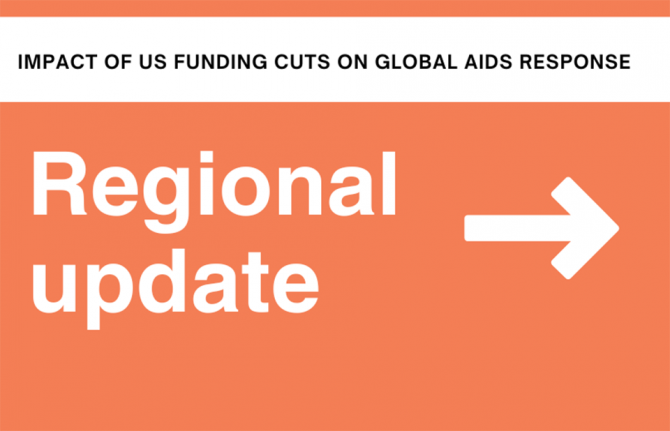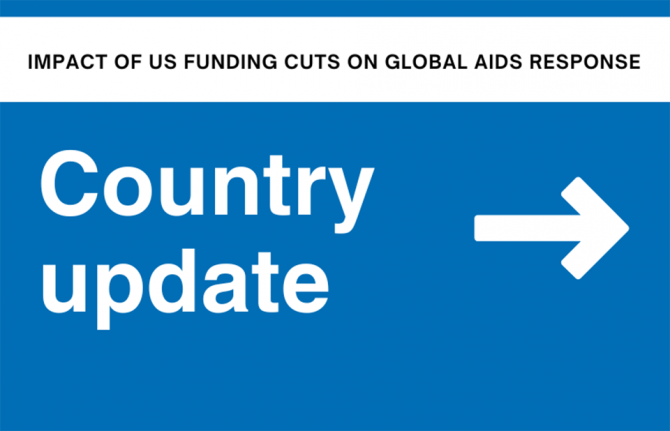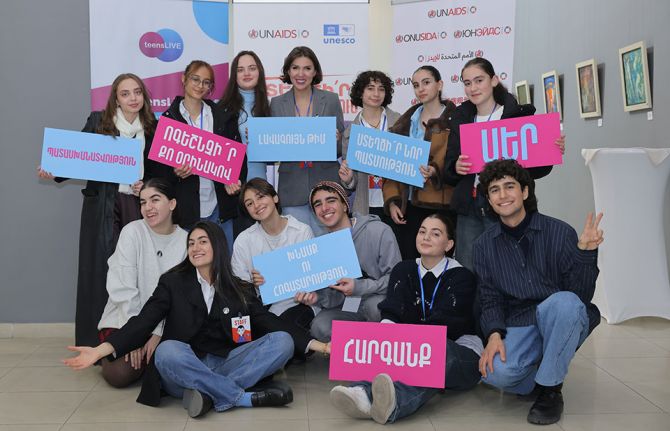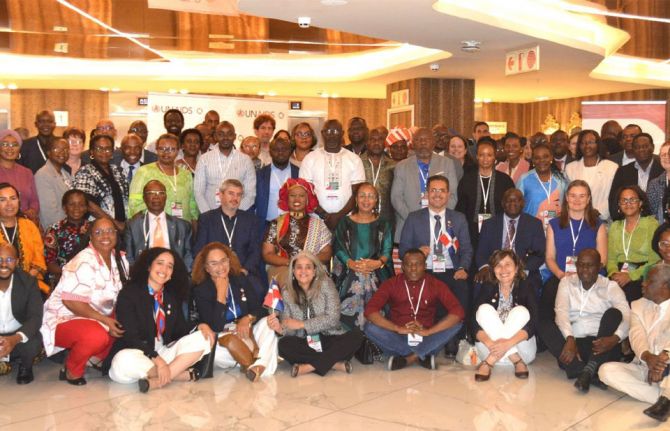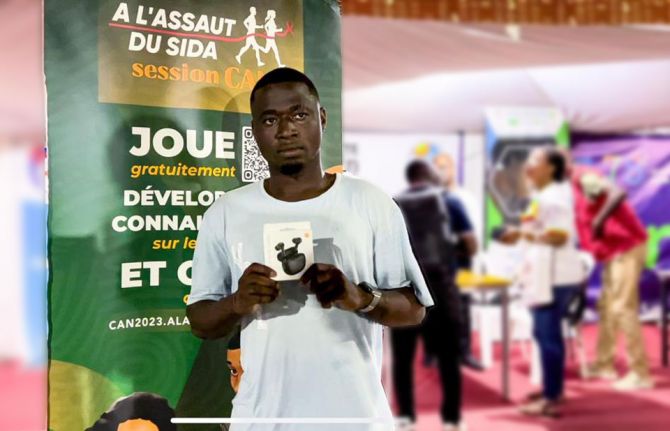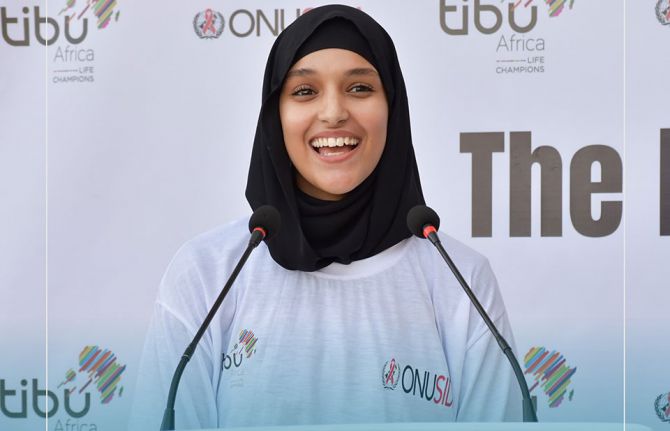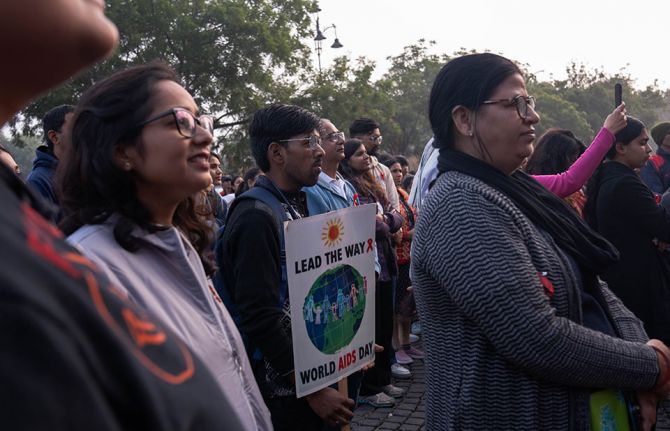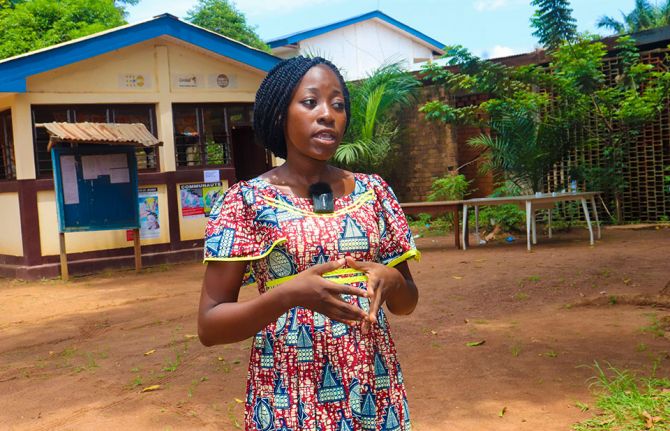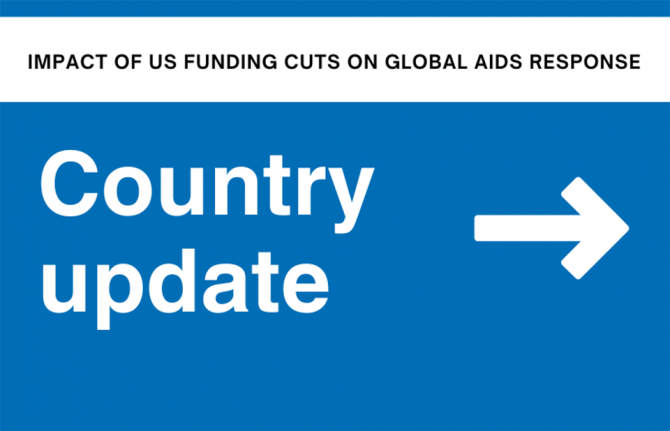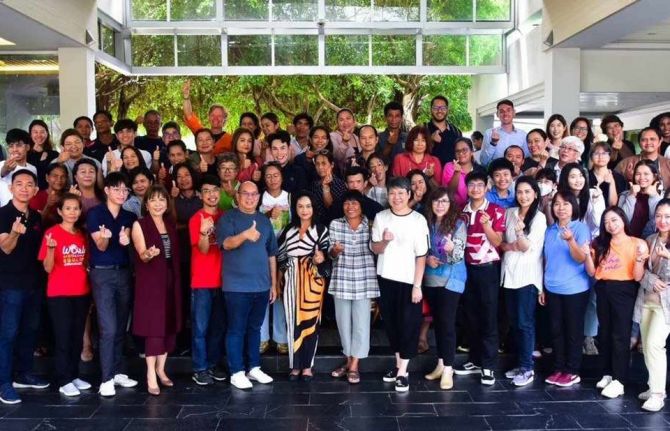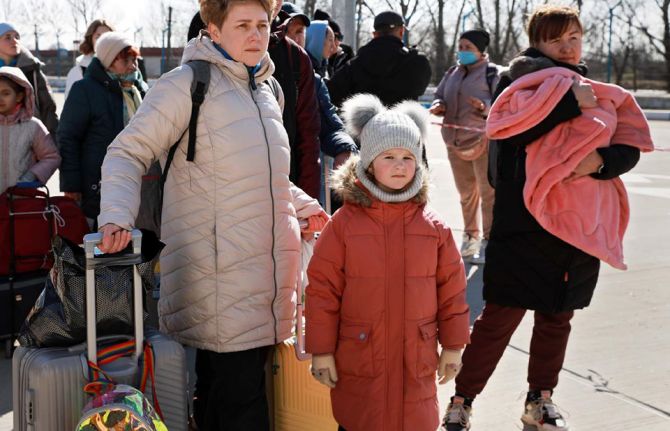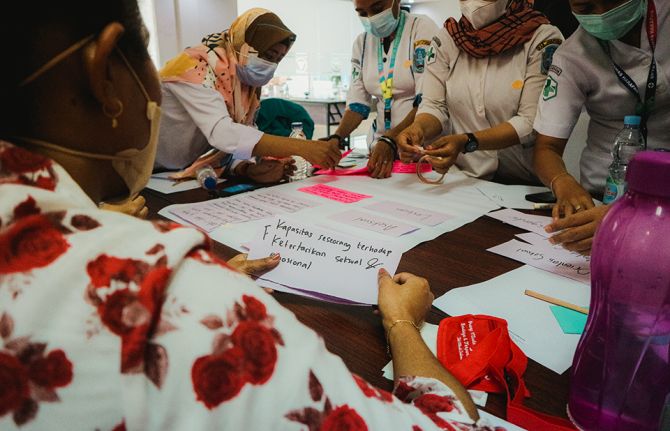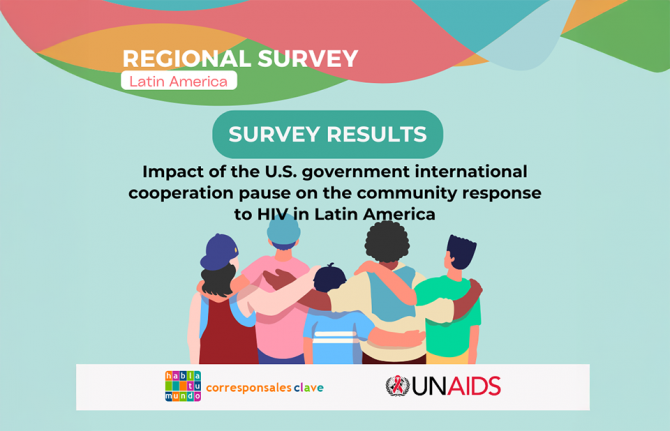
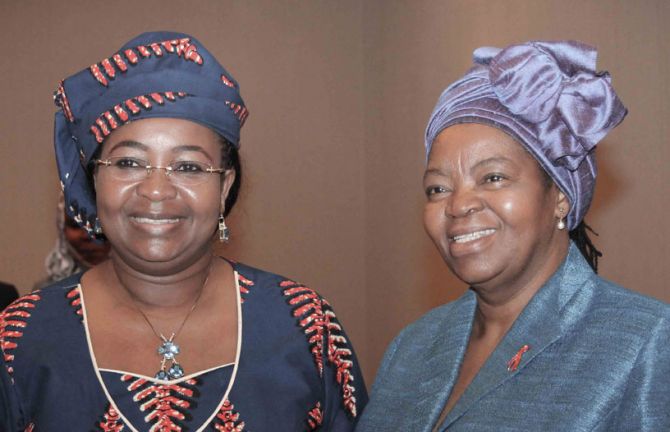
The First Lady of Tanzania, Mama Selma Kikwete (left) and Professor Sheila Tlou of UNAIDS at the recent meeting of the high level group of education and sexual reproductive health experts from Eastern and Southern Africa, held in Gabarone, Botswana from 30-31 July. Credit: UNESCO
Feature Story
Experts in Southern and Eastern Africa call for renewed commitment on sexuality education and health services
09 August 2013
09 August 2013 09 August 2013At a recent meeting in Botswana, a high-level group of education and sexual reproductive health experts from Eastern and Southern Africa highlighted the need for good quality, gender-sensitive sexuality education that prepares adolescents for puberty and relationships and prevents unintended pregnancy and HIV. They also stressed that countries need to provide improved access to youth-friendly health services, which includes contraception, confidential HIV and STI testing, HIV prevention, treatment and care, as well as safe pregnancy and delivery and safe options in the case of unintended pregnancy. Child-marriage and gender-based violence were singled out as current impediments for adolescents and young people realising their right to education and health.
The participants also called on the region’s health and education ministers to sign a new commitment to work closely together to improve access to high quality sexuality education and health services. This commitment, due to be signed in December 2013 ahead of the International Conference on AIDS in Africa, will demand that countries look at young people’s needs with more openness, and be willing to re-examine social norms about young people’s sexuality.
The meeting, held in Gabarone, Botswana from 30-31 July, was the first face-to-face meeting of this high-level group, chaired by Professor Sheila Tlou, regional directors of UNAIDS and a former Member of Parliament and Minister of Health of Botswana. The First Lady of Tanzania, Mama Selma Kikwete, opened the meeting.
Quotes
We will work hand in hand with young people, parents and communities at large to ensure that our leaders put their wellbeing at the centre of national agendas and resource allocation.
Resources
Related

Feature Story
UN Secretary-General Ban Ki-Moon launches “Education First” to send every child to school
27 September 2012
27 September 2012 27 September 2012
The United Nations Secretary-General Ban Ki-Moon launching the new initiative “Education First” with President Jacob Zuma of South Africa (left) and the Prime Minister of Denmark Helle Thorning-Schmidt (right). 26 September 2012. UN Headquarters, New York. Credit: UNAIDS/B. Hamilton
The United Nations Secretary-General Ban Ki-Moon launched a new initiative “Education First” to ensure that every child goes to school, receives quality education and imbibes values of global citizenship.
“Our shared goals are simple. We want children to attend primary school and to progress toward higher education that will help them to succeed in life,” said Mr Ban. “We cannot stop until every child goes to school. This is our task, this is our homework.”
Speaking on behalf of all children and young people, Chenor Bah from Sierra Leone presented a petition demanding their right for education. “Send us all to school; prepare us for the 21st century jobs, [prepare us] to be global citizens to promote tolerance and peace, comprehensive reproductive health education, and to be informed by science,” said Mr Bah. “You are tallest when you kneel to help a child,” he added.
“Education First” seeks to mobilize all partners, traditional and new, to achieve the enrolment of all children in primary education ahead of the 2015 target date for the Millennium Development Goals. The new initiative establishes that, an additional US$ 24 billion is needed annually to cover the shortfall for children out of primary and lower secondary school. “Education remains the most important investment that any state—especially in Africa and the developing world can make,” said President Jacob Zuma of South Africa.
Our shared goals are simple. We want children to attend primary school and to progress toward higher education that will help them to succeed in life
United Nations Secretary-General Ban Ki-Moon
Moderating the session, the United Nations Special Envoy for Global Education Gordon Brown called on the global community to invest fully in education. “We have to give voice and opportunity to young people,” he said.
More than US$ 1.5 billion was pledged during the event by private sector partners including US$ 1 billion by Western Union Foundation and US$ 500 million by MasterCard foundation.
“When you run a country you worry about a lot of statistics—inflation, unemployment, gross product etc.—but the one statistic that I worry most about is how our schooling fares compared to other countries,” said Julia Gillard, Prime Minister of Australia. “The success of our 15 year old children in education determines how far our economy will go and how fair as a nation we will be,” she added while supporting the initiative.

Moderating the session, the United Nations Special Envoy for Global Education Gordon Brown called on the global community to invest fully in education. Credit: UNAIDS/B. Hamilton
Highlighting the key role that teachers play in the children’s education, Irina Bokova Director-General of UNESCO noted that, “We need a new deal for teachers. We are short of 1.7 billion teachers,” she said. “We must put teachers first—they are the backbone of our society,” added Ms Bokova.
“We need to look beyond inputs and invest in school system to achieve better learning outcomes,” said Dr Jim Kim, President of World Bank. “Countries must invest in health and facilitate the access to school to make education work.”
In an op-ed written for the Huffington Post in support of the initiative, UNAIDS Executive Director Michel Sidibé wrote, “Education First is the blueprint for a brighter future, but it won’t succeed without steadfast commitment from all sectors of society, including governments and funders, as well as students and families. And success will require resources as well as good will. We now have an historical opportunity to end one of the greatest threats to humanity of our lifetime. Ending AIDS is possible—and education is the key to success.”
We now have an historical opportunity to end one of the greatest threats to humanity of our lifetime. Ending AIDS is possible—and education is the key to success
UNAIDS Executive Director Michel Sidibé
UNAIDS helped produce the “Education First” strategy document. The illustrations in the strategy were developed by Sujean Rim, the UNAIDS artist-in-residence. “Education is the best gift I have received and I am happy to be able to support this initiative,” Ms Rim said. “Children everywhere need the opportunity and the skills to express themselves through art, science and sport.”
Today, nearly 61 million children do not have access to primary education, 52% of them are girls. An additional 71 million children eligible for lower secondary education are not receiving post-primary education. Children in conflict-affected countries account for 42% of children out-of-school. Other barriers to school enrolment and completion include unaffordable costs, gender discrimination, child labour and lack of infrastructures. The new strategy also highlights that children orphaned by AIDS and other causes need focused care and protection, as do those subjected to child labour and exploitation.
External links
External links
Publications
Publications
Related information
Related

Feature Story
Landmark report on HIV among Zambia’s young people highlights challenges and charts the way forward
20 April 2012
20 April 2012 20 April 2012
A new report provides an extensive synthesis and analysis of recent data, gaps and challenges in AIDS prevention, treatment, care and support for young people in Zambia.
For Zambia’s young people the AIDS response has seen a number of important successes, with a significant 25% decline in HIV incidence over the last decade. However, according to a groundbreaking new report, the AIDS epidemic continues to have a huge effect on the country’s youth, especially young women, and much more needs to be done to achieve an HIV-free generation.
Situation Assessment of the HIV Response among Young People in Zambia provides an extensive synthesis and analysis of recent data, gaps and challenges in AIDS prevention, treatment, care and support for this key age group. It was launched at a high level meeting held from 17-18 April in Lusaka.
The event was supported by Zambia’s United Nations Joint Team in collaboration with the National HIV/AIDS/STI/TB Council (NAC), and the ministries of Health; Education; Youth and Sport; and Community Development, Mother and Child Health.
“We must reduce the number of new HIV infections among young people if we are to meet the targets set in the 2011 Political Declaration on AIDS,” said Deputy Minister of Youth and Sport Nathaniel Mubukwanu. “We are committed to continue developing high impact interventions using a combination of HIV prevention strategies to effectively respond to the epidemic,” he added.
Good progress but gaps remain
The assessment, focusing on 10 to 24 year olds, shows that HIV incidence decreased between 2001 and 2009 among young people and the proportion of young people having sex before the age of 15 has halved, from about 17% in 2000 to some 8% in 2009. There has also been a rise in the number of young people who were tested and received their HIV test results, from 7% in 2005 to 34% in 2009.
Providing young people with access to HIV testing, condoms, male circumcision and other reproductive health services, including sexuality education, will significantly contribute to Zambia achieving the UNAIDS’ vision of zero new HIV infections, zero discrimination and zero AIDS-related deaths
Helen Frary, UNAIDS Country Coordinator, Zambia
Despite these achievements, HIV prevalence among young people remains high. In 2007 prevalence among those aged 15-19, for example, was 6% for women and 4% for men.
This is attributed to a number of factors. Dr Clement Chela, NAC Director General, citing the report said these factors included, “Poor comprehensive knowledge of HIV; gender inequality, poverty and the combination of transactional and intergenerational sex, early marriage, alcohol use, peer pressure and the negative gatekeeper attitudes towards condom promotion among young people.” Data shows that only 53% of adults expressed support for condom education for HIV prevention among young people.
The report also highlights that there is no comprehensive sexuality education package for pupils in school and a high level of stigma towards young people on treatment from their peers.
Way forward
One of the key recommendations in the report for increasing protection of young people is the promotion of their meaningful involvement in HIV policy and programme design and implementation. This can be facilitated by building their capacity as change agents and service providers and encouraging them to generate demand for HIV-related services.
As Youth Representative Chipasha Mwansa contended, while hoping that her peers’ recommendations would be taken with the seriousness they deserve: “Nothing for young people without meaningful involvement of young people.”
According to the report, bottlenecks that need to be addressed in order to meet young people’s needs are those that affect access to condoms, HIV counseling and testing, male circumcision and behavior change communication among young people in and out of school. Furthermore, youth friendly services should be expanded at the health facility and community level, including those integrating HIV care and treatment and legal protection for adolescents living with the virus.
Helen Frary, UNAIDS Country Coordinator, noted that a multipronged approach was necessary. “Providing young people with access to HIV testing, condoms, male circumcision and other reproductive health services, including sexuality education, will significantly contribute to Zambia achieving the UNAIDS’ vision of zero new HIV infections, zero discrimination and zero AIDS-related deaths.”
To ensure that measurable progress is made in Zambia, the UN has pledged to work with relevant ministries and stakeholders to translate these main recommendations –and others— into a clear, costed and time-bound action plan which puts young people centre-stage.
External links
External links
Partners
Publications
Related

Feature Story
UNESCO Youth Forum: Young people driving the HIV prevention revolution
21 October 2011
21 October 2011 21 October 2011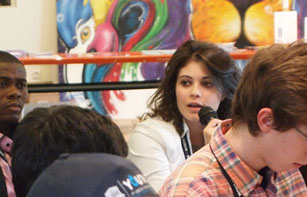
Lamia Jouini, engaging with fellow delegates in the café discussion on the third day of the UNESCO Youth Forum.
How can the world’s youth maximize their potential as dynamic agents of social, political and economic change to improve their lives, health and societies? The 7th UNESCO Youth Forum, held in Paris from 17 - 20 October, brought together nearly 250 youth delegates from 193 Member States and hundreds of civil society observers to try to find answers to this key question.
With the theme ‘How youth drive change,’ the Forum explored the myriad ways in which young people are reshaping the world. Three sub-themes looked at youth in political and public life, breaking through employment barriers, and countering youth exclusion, vulnerability and violence.
HIV remains a major area of vulnerability for young people, with 15-24 year-olds representing some 40% of new infections among adults worldwide. On the third day of the Forum, more than 30 youth delegates from around the world engaged in a ‘cafe discussion’ on HIV-related issues and AIDS activism.
During the session, organized by UNESCO, delegates were encouraged to contribute to the HIV response in their home countries. They shared diverse opinions and ideas, learning from each other’s experiences.
“I didn’t even know that there was such a thing as a female condom! It just shows the lack of information,” said Lamia Jouini from Tunisia with a slight laugh, a member of the International Federation of Medical Student’s Association. On a more serious note, she added, “The HIV situation is bad in many countries—we should really adjust our work to the needs of young people.”
The wide-ranging discussions touched on issues such as stigma and discrimination, lack of good-quality sexuality education in schools and access to commodities such as quality condoms.
I was really impressed with the work young people are doing to educate themselves and their peers, challenging stigma!
Joanna Herat, a programme specialist in the HIV and AIDS section with UNESCO.
“I was really impressed with the work young people are doing to educate themselves and their peers, challenging stigma,” said Joanna Herat, a programme specialist in the HIV and AIDS section with UNESCO, who facilitated the discussion. “Many of the delegates left the session with a strong sense of dedication to advocate for HIV-related education in their home countries.”
Developing a symbiotic relationship between young people and UNESCO as an organization was also seen as critical. Delegates took the opportunity to tell UNESCO representatives about their needs and priorities as advocates and beneficiaries. The UN agency, in turn, was able to identify activists and follow up with them for peer engagement and leadership development opportunities.
The café discussion reflected the aspirations of the 7th UNESCO Youth Forum as a whole: to encourage youth to be a force that makes a difference in the world and to be a force that drives change.
External links
External links
Related

Feature Story
Adapting to today’s epidemic: UNESCO launches its new AIDS Strategy
18 October 2011
18 October 2011 18 October 2011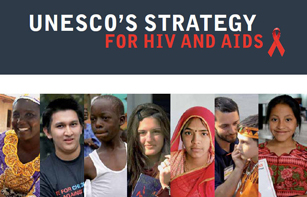
UNESCO’s new AIDS strategy intends to meet the needs of the changing face of the AIDS epidemic.
The United Nations Educational, Scientific and Cultural Organization (UNESCO) recently launched a new AIDS strategy intended to meet the needs of the changing face of the AIDS epidemic.
The strategy articulates UNESCO’s contribution to the UNAIDS strategy Getting to Zero, and calls for the need to accelerate universal access to HIV prevention, treatment, care and support.
“All parts of the Organization are mobilized at the global, regional and country levels, through activities that are culturally appropriate, gender transformative and evidence-based. This cross disciplinary approach is our signature strength and it is well-suited for tackling HIV,” said UNESCO Director-General Irina Bokova.
The launch event was chaired by Qian Tang, UNESCO Assistant Director-General for Education, who was joined by Jan Beagle, UNAIDS Deputy Executive Director, Management and External Relations and Mark Richmond, UNESCO Global Coordinator for AIDS.
Other presenters included Lady Cristina Owen-Jones, UNESCO Goodwill Ambassador for HIV Prevention Education, Nobel Laureate Dr Luc Montagnier, Patricia Machawira, UNESCO Regional AIDS Advisor for East and Southern Africa and Pablo Torres Aguilera, Young People Living with HIV Officer at Dance4Life.
All parts of the Organization are mobilized at the global, regional and country levels, through activities that are culturally appropriate, gender transformative and evidence-based. This cross disciplinary approach is our signature strength and it is well-suited for tackling HIV
UNESCO Director-General Irina Bokova
Speaking at the launch, Ms Beagle commended the new UNESCO strategy and the key role the organization plays in promoting the education sector engagement in national AIDS responses. “The UNESCO AIDS Strategy addresses critical challenges in protecting young people from HIV infection and places particular emphasis on the promotion of comprehensive HIV responses in the education sector.”
In the new strategy, HIV prevention education will be integrated within the context of wider health promotion to ensure that all girls and boys, and young women and men, have access to comprehensive health education. Furthermore, UNESCO strategy outlines three priority areas:
• Building country capacity for effective and sustainable education sector responses to HIV;
• Strengthening comprehensive HIV and sexuality education;
• Advancing gender equality and protecting human rights.
UNESCO hopes that its new AIDS strategy will reinforce the pivotal role of the education sector in a successful AIDS response. With knowledge about HIV and health issues provided in a nurturing and enabling environment, young people can make more informed choices about how to live safer and healthier lives.
External links
External links
Publications
Related

Feature Story
Building knowledge, skills and hope in southern Africa’s schools
07 October 2011
07 October 2011 07 October 2011
Learners participating in a ‘Positive Speaking’ intervention, in Luanda, Angola
Credit: UNESCO
Students and teachers in four southern African countries are benefiting from an ambitious HIV programme spearheaded by UNESCO. From its start in 2008, the programme was designed to strengthen the education sector’s AIDS response in Angola, Lesotho, Namibia and Swaziland.
Called ‘Building knowledge, skills and hope: HIV and AIDS education for African children’, the three-year project has encompassed improving the curriculum and learning materials about HIV. It has also focused on supporting teacher training with better programme and policy guidance. The programme aimed to strengthen care and support systems for learners and education personnel affected by HIV as well as to improve the delivery of AIDS education in hundreds of schools.
Implemented by UNESCO and financed by the Virginio Bruni Tedeschi Foundation, the project was carried out under the UNAIDS Global Initiative on Education and HIV and AIDS (EDUCAIDS) and reinforced ongoing work in each country’s ministry of education.
According to UNESCO the result has been the repositioning of the education sector at the centre of the national AIDS response in all four countries. Reforms are underway in all project countries to integrate HIV and sexuality education into the curricula of schools and teacher training institutions.
The initiative has led to a number of innovations such as the establishment of the first national networks of teachers affected by HIV. “Since this initiative was launched, we share our experiences, our fears, our hopes and our dreams together,” said Nelao Martin, a teacher living with HIV and a member of the EduSector Support Network on Health and HIV in Namibia. “In the past, someone somewhere has necessarily been through the same difficulties and managed to deal with it.”
Since this initiative was launched, we share our experiences, our fears, our hopes and our dreams together. In the past, someone somewhere has necessarily been through the same difficulties and managed to deal with it.
Nelao Martin, a teacher living with HIV and a member of a national network of teachers affected by the virus in Namibia
The first support groups for children and adolescents affected by AIDS have been established. Also, in partnership with associations of people living with HIV, new approaches have been used to reach out to positive learners in schools. ‘Positive Speaking’ sessions were introduced whereby personal testimonies and experiences of young, openly HIV-positive facilitators allowed pupils to ‘put a face’ to the virus.
Nkuebe Peete, an HIV-positive 23 year-old living in Lesotho has taken part in such interventions: “I am proud to share my story and experience with younger people so that they do not make the same mistakes that I made and become supportive to those who live with HIV. This has given a new meaning to my life. I now have the feeling of being a much better person than before.”
In addition, innovative teaching and learning materials have been developed such as the series of speaking books on HIV for primary pupils in Swaziland. Most materials for the sensitization of older students have been developed by the learners themselves in creative and interactive ways. One particular approach involved national and regional ‘PhotoVoice’ exhibitions which highlighted testimonies of HIV-positive learners and teachers. In total, project activities have reached more than 4 000 schools, 17 000 teachers and nearly half a million learners.
Building on the groundwork laid by the project new initiatives are being developed. For example, in May 2011 Namibia’s ministry of education mandated and budgeted for the introduction of full-time teachers dedicated solely to life skills education, guidance and counselling in all primary and secondary schools.
Lesotho and Swaziland are about to adopt policies that recognize the impact of AIDS on their education systems. Such policies call for the integration of strategies for prevention and care adapted to the needs of learners and teachers. Similar efforts have been initiated in Angola, which is addressing the formulation of an education sector strategy and policy on HIV.
Project partners believe the programme has contributed significantly to improving the AIDS response in the education sectors in all four countries. According to Majoele Likonelo Hlasoa, Director of Planning at the Ministry of Education and Training in Lesotho, “When I first joined the Ministry of Education, I did not understand what the education sector could and should do about HIV, which I considered then as a health issue falling fully under the responsibility of the Ministry of Health. Since I have been exposed to the EDUCAIDS framework for action, I have changed my mind and have a real understanding of the issues at stake.”
External links
External links
Publications
Related

Feature Story
NewGen Asia: Helping young leaders find their voice
27 August 2011
27 August 2011 27 August 2011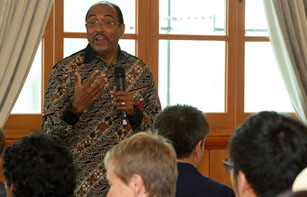
Michel Sidibé UNAIDS Executive Director and young mentees engage in discussion during the launch of the NewGen Aisa initiative.
Credit: UNAIDS/Kim
Across the Asia and Pacific region an estimated half a million young people aged 15-24 are living with HIV. A significant number of all new infections in the region are among young key populations including sex workers, men who have sex with men, transgender people and young people who inject drugs.
To ensure that people who need HIV services are reached, young people require a strong voice and increased representation in the AIDS response. An initiative called New Generation (NewGen) Asia aims to develop the capacity of the next generation of young leaders from key populations to make their voices heard.
Launched on 27 August at the 10th International Congress on AIDS in Asia and the Pacific in Busan, Republic of Korea, the NewGen programme, spearheaded by the Asia-Pacific Inter-Agency Task Team for Young Key Affected Populations, stepped up a gear with an event which showcased the NewGen Mentoring Young Leaders Programme and the official launch of a new leadership course.
“You are not just the leaders of tomorrow, you are the leaders of today,” said UNAIDS Executive Director, Michel Sidibé at the launch. “Leadership is about commitment, courage and confronting what is wrong. With your energy we can build a better world.”
Leadership is about commitment, courage and confronting what is wrong. With your energy we can build a better world
Michel Sidibé, UNAIDS Executive Director
The NewGen Asia event involved a long table lunch which brought together 30 high-level mentors and the new young leaders, predominantly from key populations, whom the mentors will encourage and support. The mentors are drawn from a diverse range of backgrounds, such as civil society, the United Nations, government and young people who already have strong leadership experience. They include among others Ursula Schaefer-Preuss, Vice President of the Asian Development Bank, Khartini Slamah, Chair of the Asia-Pacific Transgender Network and Jimmy Dorabjee of the Asian Network of People who Use Drugs.
A two-way learning and sharing exercise
“I believe NewGen mentoring component is a very important initiative to help stimulate dialogue between young leaders from key populations, who are often stigmatized or in difficult circumstances, and mentors who can help provide vision and leadership,” said mentor Ursula Schaeffer-Preuss, Vice President of the Asian Development Bank.
Gerard Ompad, a young mentee with experience in HIV prevention, thinks the NewGen Asia initiative will help him become a more effective champion of the needs and concerns of his community. “I’m very pleased to be part of this initiative. The training will empower us as young people from key affected communities to become real leaders and develop our advocacy skills. Youth ownership and leadership of the AIDS response is critical and this is a significant step forward for the region,” he said.
Youth ownership and leadership of the AIDS response is critical and this is a significant step forward for the region
Gerard Ompad, young mentee from the NewGen Asia project
During the lively lunch, mentors and mentees discussed their expectations and planned various activities over the coming year. It was generally agreed that it would be a two-way learning and sharing exercise.
Five day leadership course
The event also provided an opportunity for the launch of a five day leadership course for young people from key affected populations and those working with them. The programme has been developed and delivered by a team of technical experts from Youth LEAD, a regional network of groups committed to advancing HIV prevention. Youth LEAD members are also heavily involved in the mentoring programme in collaboration with academic experts and UN partners.
The course will include information on HIV and key affected populations and will have a special focus on skills-based training, including advocacy, communication and leadership.
In a further commitment to championing youth engagement in the AIDS response, Youth LEAD, in collaboration with the HIV Young Leaders Fund also launched a request for youth lead initiatives working to address the needs of those most affected by HIV in Southeast Asia and the Pacific for its 2011-2012 funding round.
It is hoped that the multi-pronged NewGen Asia initiative will reap clear benefits in increasing the effective engagement of key communities which are bearing the brunt of the AIDS epidemic in the region.
Anupama Rao Singh, UNICEF's Director of East Asia and the Pacific Region commented on the importance of the NewGen initiative:
“Young people most affected by the AIDS epidemic are at the heart of prevention revolution in Asia and the Pacific. The NewGen Asia initiative, with support from the regional inter-agency task team, will build young people's leadership to advocate policies and programmes that concern them and prepare a new generation of change agents for the region's AIDS response.”
External links
External links
Related

Feature Story
It’s possible: Making the most of linking sexual and reproductive health and HIV responses
09 June 2011
09 June 2011 09 June 2011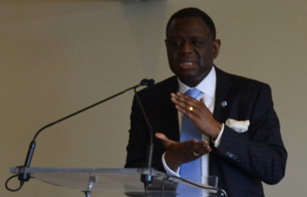
Dr Babatunde Osotimehin.
Credit: UNFPA
Linking sexual and reproductive health and HIV is of critical importance. Worldwide more than 80% of HIV infections are sexually transmitted. In addition, sexual and reproductive ill health and HIV are fueled by similar causes such as poverty, limited access to services, lack of correct information, gender inequality and social marginalization.
On 8 June, during a side event at this week’s General Assembly High Level Meeting on AIDS in New York, the question of how exactly such linkages can be strengthened was explored. The event was sponsored by UNAIDS, the UN Educational, Scientific and Cultural Organization (UNESCO), the UN Population Fund (UNFPA), the World Health Organization (WHO), and the International Planned Parenthood Federation (IPPF).
The highly interactive session looked at the issue through the prism of five key thematic areas: cost-effectiveness and cost savings of linkages; prevention of mother to child transmission though a sexual and reproductive health platform; comprehensive sexuality education for young people; ending gender-based violence; and human rights of people living with HIV.
Making ‘people-sense’
In his opening remarks, Dr Babatunde Osotimehin, UNFPA Executive Director, explained how the integration of sexual and reproductive health and HIV services makes ‘people-sense’. These services include testing for HIV and other sexually transmitted infections, prevention of mother-to-child transmission, support for fertility decisions, and access to condoms, contraception and correct information. He went on to emphasize wider policy and human rights implications.
“Linking sexual and reproductive health and HIV goes beyond integrating health services,” he said. “It demands from us that we fortify the human rights platform–ending stigma, violence and discrimination.”
Human rights and the right to health were said to be at the core of greater integration of services. A broader human rights agenda can also be promoted that goes beyond service delivery and tackles legal reforms, such as those relating to the right to information and freedom from violence, abuse and coercion.
Sharing ideas and experience
The participants shared ideas and experiences of how those working in the fields of HIV and sexual and reproductive health have combined their efforts to make interventions more effective in creative and innovative ways, including strategies to strengthen treatment as a prevention option.
It was stressed that mother- and child-centred care can improve both sexual and reproductive health and HIV outcomes. For many women, pregnancy is the first point of access in the health system and they can benefit from a range of interventions, including HIV prevention and treatment integrated into routine maternal health care; family planning; and preventing and managing sexually transmitted infections and gender-based violence.
The discussion also showed that when comprehensive sexuality education is effectively implemented on a national scale, there is potential for cost saving from averting HIV infections, other STIs and unintended pregnancies.
Participants examined how men can benefit from greater integration. For instance, in countries where voluntary male circumcision is being implemented for HIV prevention, the number of men accessing other sexual and reproductive services, such as prevention of mother-to-child transmission and treatment of STIs, has increased.
The meeting closed with agreement that linking sexual and reproductive health and the HIV response, especially in a climate of austerity, is a gateway to strengthening both the human rights agenda and health systems.
External links
Related

Feature Story
UNESCO: Sexuality education for young people highly cost-effective
06 May 2011
06 May 2011 06 May 2011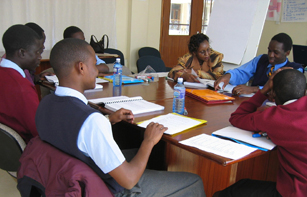
Students working with the Kenya government officials on sexuality education
Credit: UNESCO/Kenyan Centre for the Study of Adolescence
Sexuality education programmes can be highly cost-effective, especially when compulsory, adapted from existing models and integrated into the mainstream school curriculum. This is the major conclusion emerging from a seminal study released by UNESCO during a meeting of the UNAIDS Inter-Agency Task Team on Education in New York on 27 April 2011.
The study, Cost and cost-effectiveness: Analysis of school-based sexuality education programmes in six countries, examines a range of programmes in Estonia, India, Indonesia, Kenya, the Netherlands and Nigeria. It highlights significant cost savings in a number of settings. It also shows that compulsory programmes are more cost-effective as they reap the benefits and greater impact of full coverage of the student population.
For example, in Estonia a national sexuality education programme was introduced and linked with accessible, youth-friendly sexual and reproductive health services. Between 2001 and 2009 some 13 490 ‘health events’ were averted in the country, including nearly 2 000 HIV infections, at a potential lifetime cost of US$ 67 825 per patient, approximately 4 300 unintended pregnancies and more than 7 000 sexually transmitted infections.
We now have the data and analysis to make a stronger and better informed case for investing in school-based sexuality education programmes, particularly in those countries most affected by the epidemic and prioritized for attention in the new UNAIDS Strategy 2011-2015
Mark Richmond, UNESCO’s Global Coordinator for HIV and AIDS
The report also provides a detailed breakdown of the costs per learner of each completed sexuality education curriculum in the six countries. This ranges from US$ 6.90 in Nigeria to US$ 32.80 in the Netherlands. There are significantly higher costs in smaller pilot programmes, such as Kenya and Indonesia.
According to Mark Richmond, UNESCO’s Global Coordinator for HIV and AIDS, the landmark study gives an economic basis to the argument that sexuality education provides a key platform for HIV prevention amongst young people.
“We now have the data and analysis to make a stronger and better informed case for investing in school-based sexuality education programmes, particularly in those countries most affected by the epidemic and prioritized for attention in the new UNAIDS Strategy 2011-2015.”
Reducing the sexual transmission of HIV by half by 2015, including among young people, is one of the goals of the UNAIDS Strategy. However, the 2010 UNAIDS global report shows a critical gap in comprehensive prevention knowledge about HIV amongst this age group and that about 40% of all new HIV infections among adults occur among young people aged 15-24. Cost and cost-effectiveness adds to the growing recognition that school-based sexuality education has the potential to play a key role in improving young people’s knowledge for HIV prevention.
Inter-Agency Task Team on Education
Formed in 2002, the Inter-Agency Task Team on Education is convened by UNESCO and brings together UNAIDS Cosponsors, bilateral agencies, private donors and civil society partners to accelerate and improve a coordinated and harmonized education sector response to HIV.
External links
External links
Related

Feature Story
New monitoring centre helps tackle HIV in prisons in Latin America and the Caribbean
20 April 2011
20 April 2011 20 April 2011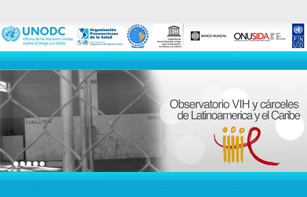
Observatorio VIH y Cárceles de LatinoaMÉrica y el Caribe
Mounting an effective challenge to HIV in prison settings is a key part of the AIDS response at national, regional and global levels. To define standards for HIV prevention and treatment and the protection and promotion of prisoners’ human rights, it is important to consolidate as much data as possible about the epidemic in this environment. The newly established Monitoring Centre for HIV and Prisons in Latin America and the Caribbean is set to become the key regional repository for such vital information.
The Monitoring Centre—called the Observatorio VIH y Cárceles de LatinoaMÉrica y el Caribe in Spanish—gathers data from 23 countries which is accessible via a web site. Its primary aim is to help governments and civil society define and implement national HIV prison policies based on international standards. Up and running in Spanish since mid-February, an English language version will be launched 30 April 2011.
The United Nations Office on Drugs and Crime (UNODC) is spearheading the initiative with support from the UN Educational, Scientific and Cultural Organisation (UNESCO), the Pan American Health Organization (PAHO), the World Bank, the UN Development Programme (UNDP) and UNAIDS.
According to José Vila del Castillo, UNODC Regional Advisor, “The Monitoring Centre shows the United Nations system ‘delivering as one’. Addressing HIV in the region’s prisons has become a priority. The centre is an important tool to catalyze prison reform processes and HIV penitentiary programmes.”
Addressing HIV in the region’s prisons has become a priority. The centre is an important tool to catalyze prison reform processes and HIV penitentiary programmes
José Vila del Castillo, UNODC Regional Advisor
Providing a permanent public space for informed reflection and dialogue, the virtual centre develops methodologies for collecting, processing, analysing and validating the scientific data gleaned on what works, and how best to proceed, in addressing HIV in prisons. It will highlight existing information and encourage ongoing research. Training and technical support are also offered through reference directories, online consultations, discussion forums and virtual classrooms.
In Latin America and the Caribbean, as elsewhere, many prisoners are vulnerable to HIV due to a number of factors, including the relative lack of knowledge about the virus among this population, overcrowding, lack of access to protection and good quality health services and violent conditions.
Across the region, where data are available, several countries have higher HIV prevalence in the prison population than in the general population. For example, according to data collected by UNODC this year, in Peru there are more than eight times as many people living with HIV in prison than outside (4.03% versus 0.4%). In Bolivia the situation is even starker; the same source documents show that in nine prisons in the country, 10% of prisoners are reported as HIV positive, compared to 0.2% prevalence in the wider society.
César Antonio Núñez, Director of UNAIDS’ Latin America Regional Support Team, believes the Monitoring Centre will provide a valuable insight into the lives of a neglected population, “The Centre will really help us to know the true HIV situation in the penitentiary system, and shed light on human rights-related issues. It is probably in the environment of HIV and prisons where UNAIDS’ commitment to being ‘the voice of the voiceless’ is most needed and appropriate.”

